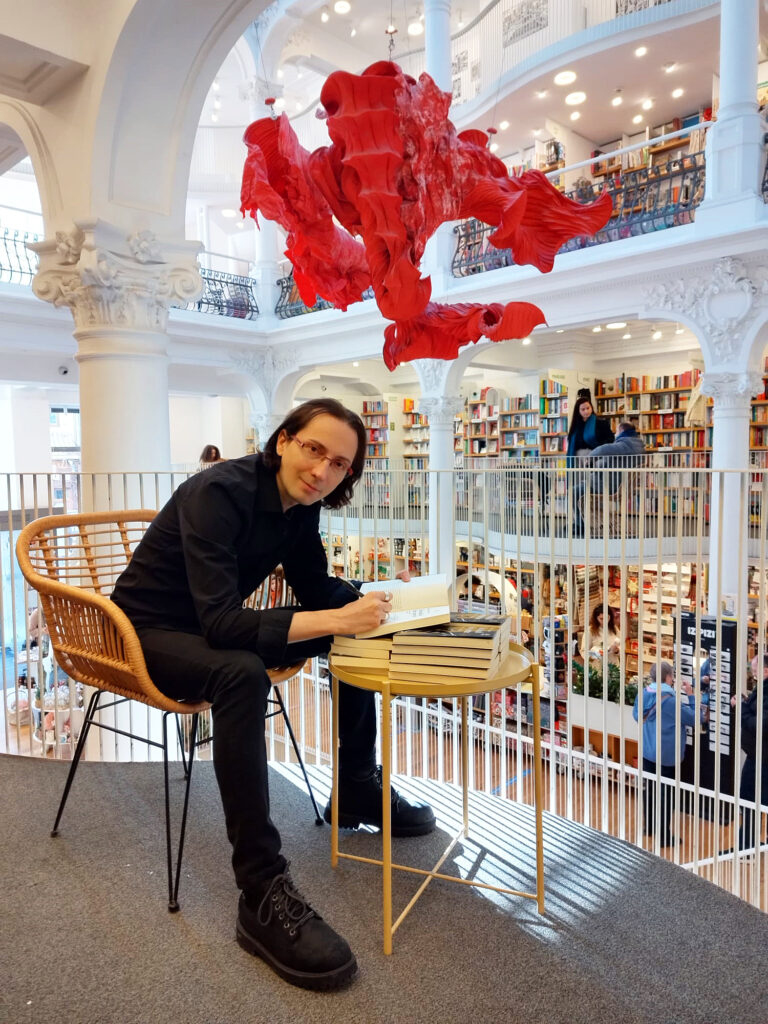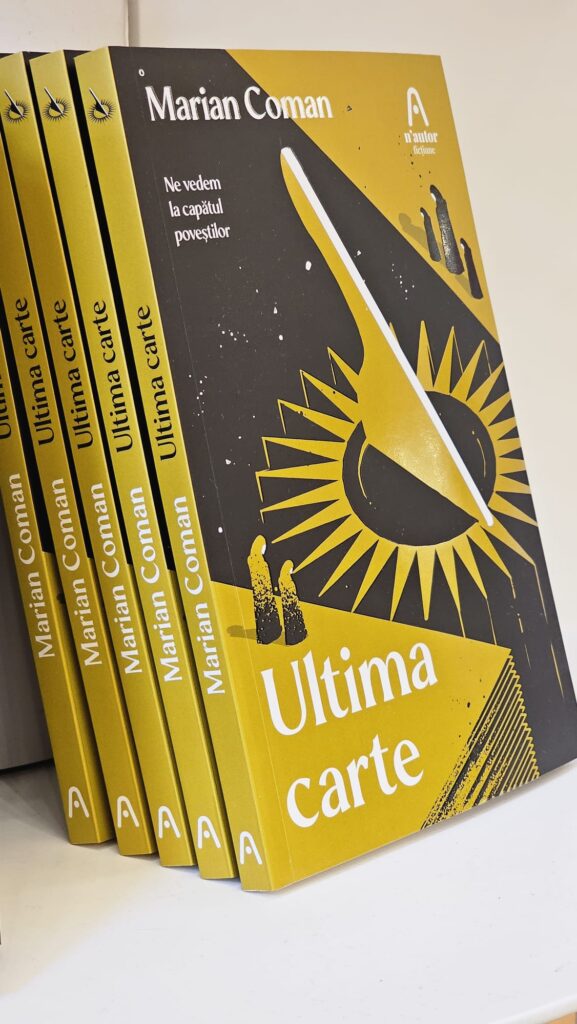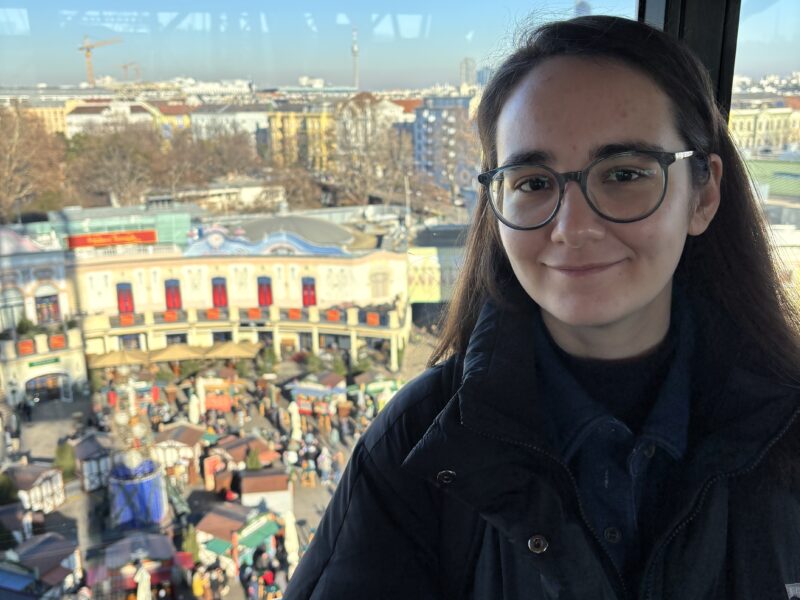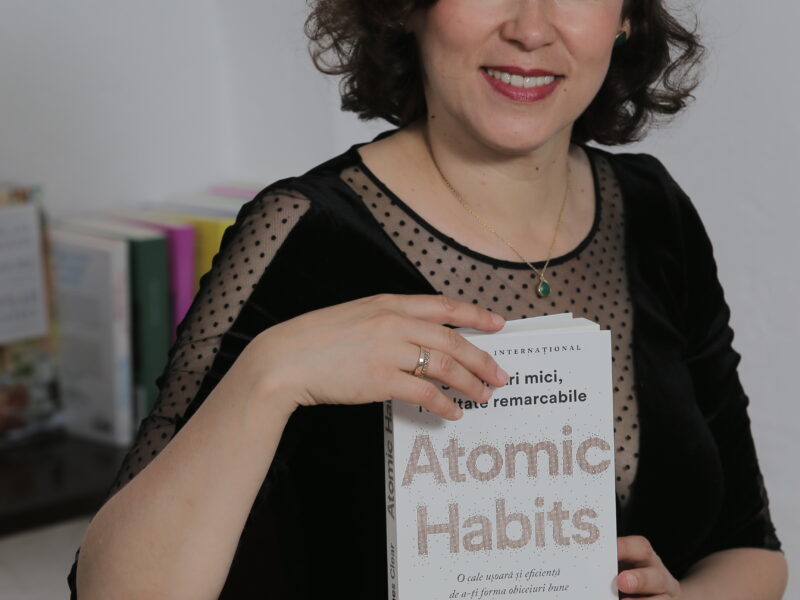Marian Coman is a writer and coordinator of the Armada and Nezumi imprints within Nemira Publishing House. He worked in the media and television and, for a while, devoted himself exclusively to writing, being part of the HAC!BD project, where he published the first graphic novels in the Haiganu trilogy and wrote scripts for the comics Harap Alb continues and Youth everlasting. He debuted in volume in 2005 at Tritonic Publishing House. His most recent volumes are the collection of short stories The Little Man in the Wall and Other Fantastic Stories and the novel The Last Book (n'n'author collection, Nemira). He is a member of PEN Club Romania and of the Science Fiction & Fantasy Writers Association (SFWA)). Proving that passion for literature and professionalism are unbeatable when they go hand in hand, Marian ended up not only editing the books of the authors with whom he grew up with, but also sharing the shelves of libraries and bookstores with them.
You were born in Mangalia and lived in Brăila. The sea or the river? And, if we go further, which are the „sea-books” and which are the „river-books” that marked your journey as a reader?
I believe there is a time for the sea, as there is a time for the river, and as there is a time for the mountain. My first six years of life are related to the sea, to my childhood in Mangalia in the late 70s- early 70s80s. The memories and that place are so warm, pleasant, that great period remained in my affective memory as a place of nostalgia, a space in which I return to when I need to recharge, while Brăila remained with me in my memory as a place charged with a certain type of urban violence, but also a space of friends from adolescence. Sea-books are the books of my childhood and adolescence, they are Verne's novel The Mysterious Island , they are Mark Twain and Dickens, then Frank Herbert's Dune and Stephen King's first novels. These are the books in which I lost myself, in which I drowned, realizing how amazing literature can be and what extraordinary things can the human mind do. The river books are the ones that grabbed me and took me away, they are the novels that accentuated my maturation, they are Hesse's Steppe Wolf , there are the stories of Kafka and Poe, but also the novels of Dostoevsky. Somewhere in between are the Romanian Symbolists, Bacovia, Macedonski and Minulescu.
You debuted at the age of 17, when you published your first story in the Supernova supplement of the Evenimentul in Iași newspaper and that's when you made your first money from writing, as you confessed. How did this debut take place and then how was the collaboration with Tritonic publishing house, where you published the first volumes as an author?
Around the age of 16, I had a few drawings in Jurnalul SFmagazine, but I had a writing itch that I couldn't scratch, so I sent my first story to Anticipațiamagazine, where I dreamed of making my debut because it published the writers I adored at that time: Arthur C. Clarke, Philip K. Dick, William Gibson. The other day, I met in Bucharest with Mihai Dan Pavelescu, who was then editor-in-chief of Anticipația magazine, and I told him how much the letter I received from him all the way back in 1994 meant to me, a letter in which he explained why he did not publish my text, but also what he thought I should still work on. The idea is that I took Mr. Pavelescu's letter very seriously, I rewrote the story, but I didn't have time to resend it to the magazine's address because, during a visit to Iași, I read it in the meeting of the Quasar cenacle, which functioned in the Students House. The text grabbed the attention of Vlad Frânghiu, one of the editors of supplement, who asked me for it. Consequently, my rewritten story for Anticipația was published in supplement. I also received royalties for my small text, so in my teenage mind, already trained to imagine impossible things and to idealize, the perspective of an entire writing career was already built and the illusion that a literary industry similar to the one in the States operates in Romania, which I had already read about through various articles and interviews with the writers I revered at that age. From the first published story to the first published book, however, more than ten years passed, during which I continued to publish in magazines and participate in all kinds of competitions, but also to dispel the illusion built in my adolescence that I could live by writing literature in the Romania of those years. However, in the end I chose to make a living from writing and that's how I became a journalist. First collaborating with Opinia studențească, during my college years, then, back in Brăila, working as a reporter in the local press. In 2005, I collected my stories in a volume that I sent to Michael Haulică, with whom I had an old friendship. I still love Michael's writing and have great faith in his advice, so I had sent him my little volume, White Nights, Black Days, just for an opinion, not knowing that in those very days he was about to become editor-in-chief of Tritonic, where he was going to publish, for the first time in Romania, books by Neil Gaiman, Jeff VanderMeer and China Mieville. And myself. I still remember Mike's phone call: "Marian, are you ready to sign a publishing contract?". I also worked with Michael on the second volume, The Chocolate Testament. Then, after Mike left Tritonic, Bogdan Hrib proposed to me to collect my editorials published in newspapers in a publication volume. It was called The Phlegm Theory. Call for Bribery. After that there was a long pause.
Before joining the Nemira team you lived exclusively from your writing, the dream of all writers, working on the Haiganu trilogy and the scripts of the comics Harap Alb continues and Youth everlasting. How were those years and how was the HAC!BD project born, which laid the foundations, Ithink, of the Romanian comic and graphic novel market?
It happened that I had almost given up on fiction. I was focused on my existence in the media, I had the small local battles, a team to manage and a daily paper to do six days out of seven. I was editor-in-chief of the newspaper to which I dedicated some years of my life, and I wrote literature rarely, one story at a time, in case someone remembered me and asked me for a text for an anthology. One evening, on Facebook, I saw an ad for the project Harap Alb continues and I remembered the drawings I used to make as a child trying to imitate Pif and Rahanmagazines, but also the fact that, only a few months before, I had signed an article in the American magazine Weird Fiction Review, in which I had talked about the characters in The Tale of Harap Alb, which I had compared to the mutants in the X-Mencomics. Although I'm not in the habit of approaching strangers on Facebook, I felt the need to congratulate the originators of HAC!!. An hour later after my little congratulatory message, I was getting an invitation from the publisher to write a story for their project. A month later the first issue of the magazine appeared and the first chapter of Haiganu, which was supposed to be a short story. Four months later I was writing my first comic script. Two years later my first novel Haiganunovel appeared, I quit my job at the newspaper and did what I had dreamed of as a teenager: I wrote stories and was paid well enough for it that I didn't need to do anything else. It was, in many ways, one of the most enjoyable experiences of my life. First, the collaboration with Mihai Ionașcu, the editor of the magazine, and with the artists involved in the project – Octav Ungureanu, Andrei Moldovan, Bogdan Chelaru and Daniel Rosa Duran, then the meetings with the readers, who charged me with energy and motivated me. The comic book audience is completely and utterly special. It's hard for me to describe to you, for example, the feeling I had when I saw a female reader dressed as one of my characters. Or the one we had when we saw a hall at Romexpo full of people who had come especially for our launch.
The most recent volumes, the collection of short stories The Little Man in the Wall and Other Fantastic Stories and the novel The Last Bookwere published in the n'author collection of Nemira Publishing House. How was the collaboration with Eli Bădică on the texts? Were there negotiations in drafting, or compromises needed to be made, or maybe a phrase or a word that sparked some discussions?
In On Writing: A Memoir of the Craft, , Stephen King writes that „the publisher is always right”. And then he completes, saying „writing is human, editing is divine”. To be an editor is to show a lot, a lot of altruism, it means, among other things, to have a writer's mind, but to use it for other people's books. King speaks the truth: „the publisher is always right”. And if you feel like he doesn't, it means it's time to stop working together. One of you will be full of frustrations, and your story will not end well for the only thing that really matters: the book both of you want to publish. I collaborated excellently with Eli Bădică, the only discussions that went into overtime were related to the titles of the two volumes and the illustrations of the covers, but I think that these are natural things, especially since they go beyond the binomial author - editor, involving illustrators and, say, marketing strategists.
One of your characters creates the perfect space for him to write: a secluded place in the mountains, with no phone connection and no internet, with the sound of a river in the background. Do you have a habit for writing? Where, how and when do you write?
The problem I face while working in a publishing house, reading manuscripts, living in the worlds imagined by other authors is that I can't always sit down at a table and start writing. I need longer periods away from texts at work, and yes, I tend to take a vacation and isolate myself somewhere to write. Last year, for example, I rented a house in an almost deserted village in Bulgaria, in an area not at all attractive from a tourist's point of view. But that's not a rule, and neither a habit. It's the ideal case. Otherwise, I can write anywhere, including at home, if I have a bit more spare time and good music in my headphones. In fact, I think that music is, for me, the only absolutely essential component. It helps me quickly project myself into the state I need for writing.
You have been working at Nemira publishing house since 2018, where you coordinate the Armada and Nezumiimprints. How did you end up at Nemira and what were the beginnings here like?
You know, I'm one of Nemira's fans and one of the geeksof the 70s90s. When I was in high school, I collected titles from the Nautiluscollection. Nemira is the publishing house that gave me Frank Herbert, Stephen King and Ursula K. Le Guin when I was 16. I met Valentin Nicolau in the 70s90s and I admired what he managed to build, I loved the fact that he coloured my adolescence with some stories that the generations before mine did not have access to and I will always be grateful to him for this. I was writing for HAC! in 2015, when I found out that Valentin Nicolau is gone and I felt that I had lost something precious. I think that a year or two later I met Ana Nicolau and, after I moved to Bucharest, I visited her at the publishing house. What I don't think I ever told her is that I lost my father around the same age as she did, and I admired her for the strength she had, to be less than 30 years and to take over Nemira and perform in this fickle market is a great deal. Ana suggested that I should resume the Nautilusmagazine project, which I did for a few months, then some discussions popped-up about a new imprint dedicated to science fiction, fantasy and thriller literature, an imprint designed for a new generation of readers. In 2018, at Gaudeamus, the first Armada novels appeared. In Nemira I discovered a very cool energy that has its roots in the passion for books and the story itself, but that was to be expected. Basically, I don't think there is a publishing house where you don't find that. What is different, I think, at Nemira, is the fact that the publishing house is, first of all, a family business, and a certain type of affective, emotional connection has been transmitted in the relationships and in the company. I have always been a prodigal son, but when I started working with Ana and the other colleagues, I had the strange feeling that I had returned home. I don't want to idealize, it's not all bright days anywhere and I'm not exactly a man without whims either, working in a publishing house often resembles that of a crew on a ship during a storm, especially when the bookfairs are approaching, but it's already been more than six years since I've been with Nemira, and it still gives me great pleasure to spread the sails to catch that good wind.
What does your working day look like now?
I would start with the fact that not all days are the same. Three days a week I go to the publishing house, and the other days I work from home. Basically, my time is divided between reviewing manuscripts, working on some books in various stages, feedback on illustrations, meetings, discussions with other colleagues, interviews, BT-s, many emails and a lot of Excel spreadsheets. Once a month I meet with some very cool people at the Armada Book Club, which will soon reach its 100th edition.
Armada contains not only some of the newest and trending titles in the area of SF, Fantasy and Thriller in the world literature, but also many books that were the basis of blockbusters, such as Dune, Game of Thrones or Witcher. How have screenings changed sales, maybe you can give us some numbers?
Successful or not, some screen adaptations have the gift of putting books in the spotlight, taking them out of the rather tight bubble of genre fans and bringing them into the mainstream, giving them access to a new audience. Dune is indeed the best-known example, but recent years have been very generous with many other titles in the Armada portfolio. I would mention, for example, Remembrance of Earth's Past, Liu Cixin's trilogy that is the basis of the series 3 Body Problem, Hugh Howey's series The Silo , screened for Apple TV, George R.R. Martin's Fire and Blood, the source of inspiration for the Rise of the Dragon series, as well as The Ballad of Songbirds and Snakes by Suzanne Collins, the prequel to the much more famous Hunger Games series. I can't give numbers, but I'll remember that all these books have had substantial print run extensions.
Nezumi is the first imprint in Romania dedicated exclusively to manga translations. How did you venture into this endeavour? I know it can be risky, for many of the readers of the genre once prefer to read the English translations.
It was the passion for comics that we had already brought to the publishing house, it was the Armada Comics collection, in which we published the Dune, it was the signals coming from the market and the discussions with our teenage readers, and it was Ana Nicolau's desire and courage to enter on this niche. I think it was important that some of the most widely read manga series worldwide were also accessible to the public in Romania, in Romanian. The series we publish in Nezumi are translated directly from Japanese by young professionals who are passionate about manga and connected to Japanese culture, which is slowly becoming a strong argument for those who used to read the English translated editions.
Is the rights acquisition and publishing process for manga volumes different from Armada titles, be they "classic books" or comics? How does the path of a Nezumi volume look like in your publishing house?
Basically, the process is similar. However, the beginning was difficult, because a particularity in relations with our Japanese partners is related to the way they relate to an important value for them: tradition. So, the first questions I received from them was if Nemira had ever published manga before, then if any manga series had appeared in Romania. Since the answers were both negative, it was difficult to break the vicious circle we had entered because it is impossible to check the tradition chapter when you are pioneering. Publishing a manga volume involves a complex team. In addition to the translators, Nezumi also includes the editor Andreea Roșeț, as well as external collaborators for DTP and lettering, people who have experience in various comic projects.

You said at one point that „the question that every writer and publisher in the country should ask themselves is how to reach the audience” that attends Comic Con. You made it to East European Comic Con both as a writer and as an editor. What does this experience mean for a publishing house?
I must emphasize that I was saying this six to seven years ago, referring to Romanian SF & Fantasy publishers and authors, in the context of a discussion about readers' lack of interest in the titles of Romanian genre writers, and I was urging them to step down from their ivory towers and meet their potential audience. You know, I've been attending Comic Con for over ten years now, either as an author or as a publisher, and I think the event is the perfect opportunity to get in direct contact with a good portion of the audience you're trying to reach if you're publishing sci-fi & F. As an author and editor, I am interested in teenagers. I want to meet them, understand their interests, see how the passion for a certain area of pop culture transforms from one generation to another. And I don't do it just at Comic Con. I take advantage of every opportunity to meet with high school students and college students, and I enjoy not only the information I gather from them, but especially the special energy they have, this lively and sincere passion with which they are endowed and which it's viral.
Childhood can taste and smell like pancakes with apricot jam. What is synaesthesia of these years and what are the books and music that accompany it?
Most of the books I read are the ones I'm looking for what we're going to publish in Armada, so it's a lot of sci-fi, fantasy and thrillers. Then I try to keep up to date with what Romanian authors are writing now, I am interested in the books that appear in the n'autor imprint, but also in the collections of contemporary Romanian literature of other publishing houses. And since we have come to this, I think that Romanian literature is going through a very good period and I am happy not only because a lot is being published, but especially because readers are more and more interested in the stories of our authors. Then the rest of the time I explore. So, this week for example, I've combined a horror graphic novel from Kodansha with a hard sci-fi that caught my attention for Armada, along with Întinde mâna, Tiberiu!!, Horea Sibisteanu's novel, and Alex Schulman's Malma Station . Musically, I am most happy with the return of the guys from the band Changing Skins who dedicated their new song to the novel The Last Book. My playlist these days includes, among many others, Byron, The Mono Jacks, Om la Lună, Jonathan Bree, Admiral Freebee, The Dø, Michelle Gurevich.
[Photos are part of Marian Coman's personal archive.] [Translated into English by Edward Vasile.]




